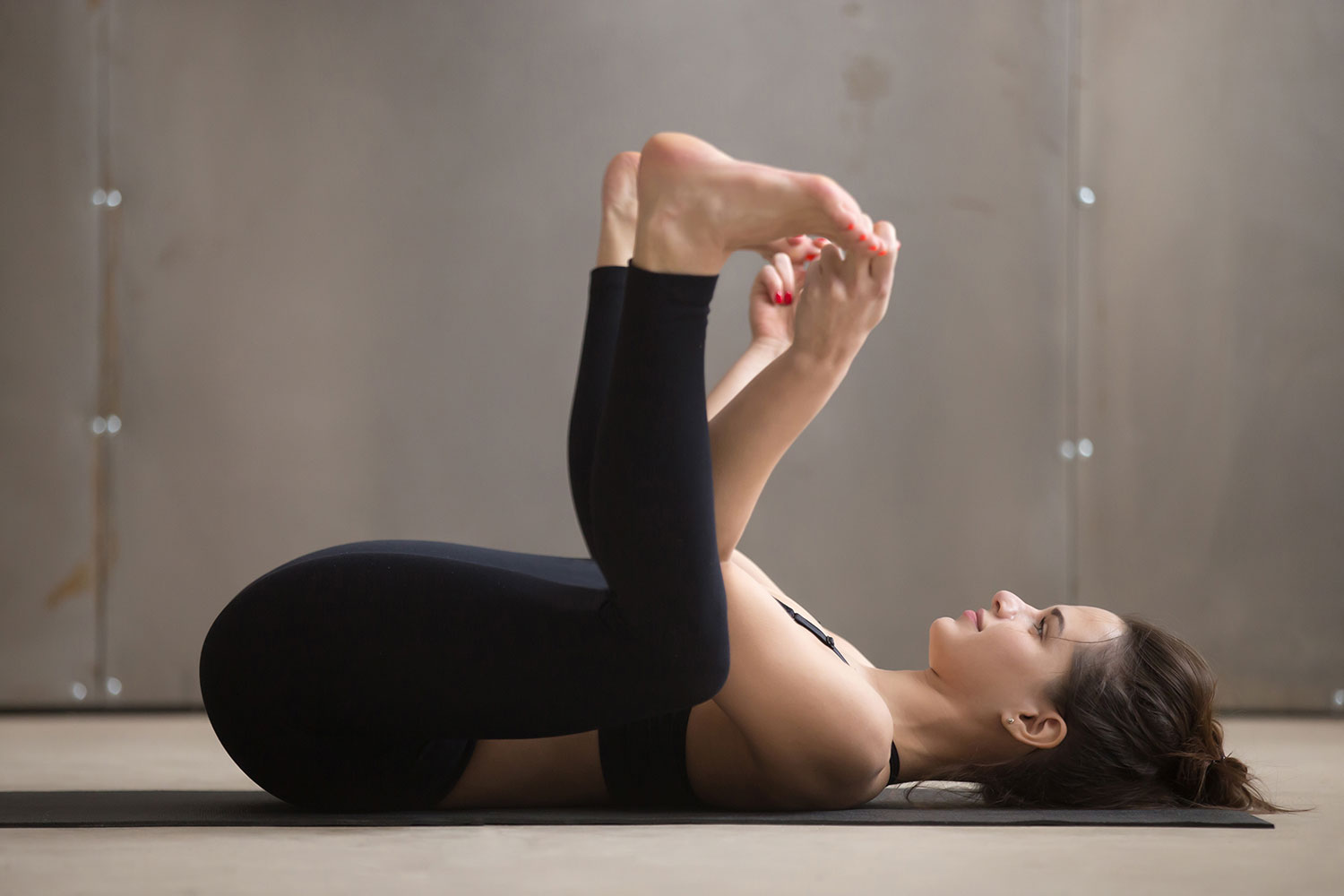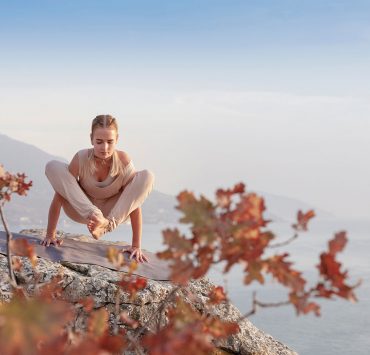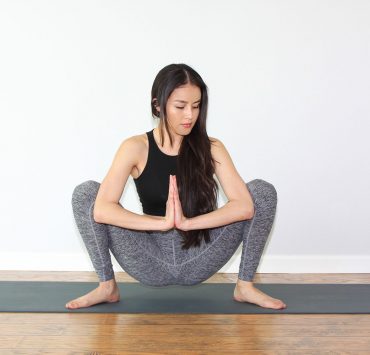
After spending nearly two decades as a relationship therapist, Patricia…
There isn’t a name more fitting for this powerful hip-opener that evokes tranquillity in body and mind. The reclined shape and optional rocking movements resemble a joyful baby which brings warmth to the spirit. Happy baby pose, or Ananda Balasana, makes space in the inner and outer hips while relieving tension in the lower back.
You can expect to meet this posture in a variety of yoga classes as it’s the perfect cooldown for heat-building practices while also being a great option in yin or restorative styles. Depending on the desired outcome, this pose can either excite energy in the upper body or leave room for a full body release. Let go of inhibitions and embrace your playful side in this calming shape.
Origin

‘Ananda’ translates in Sanskrit to ‘bliss’ and ‘bala’ to ‘child,’ resulting in the popular name ‘happy baby pose.’ The story behind this pose involves Dasharatha, the King of Ayodhya, and his desire for a rightful heir. He had three powerful wives, but no children and this caused upset in throughout the kingdom. Mother Earth was also praying for a protector to keep her natural splendor safe from over-indulgence and destruction. Dasharatha served as the protector of dharma, and Mother Earth’s call summoned Vishnu the preserver to return order to the weakened wick of dharma. Vishnu uses birth to bring the divine, known as avatars, earthside for protection against certain evils.
These avatars represent untapped potential waiting to be discovered. The king presented a sacrifice that yielded golden milk pudding, which was divided among his three wives. They all became pregnant and gave birth to Dasharatha’s champions, bringing balance to dharma and salvation to the Earth. The deities of mythology are said to represent aspects of ourselves and how we relate to our body and mind. For example, Dasharatha translates to ‘ten chariots’ and signifies our body as the chariot being drawn by the horses of our senses. Intelligence drives the chariot with our soul serving as the rider and our mind acting as reins.
This image embodies one who commands authority over the mind and body, similar to a yoga practitioner. By gaining control over our senses through yoga or meditation, we’re manifesting our inner divine qualities, and from that, a happy baby is born.
Physical Action Of The Pose
As with many yoga postures, it’s important to breathe into this shape and express patience as the benefits unfold. Happy baby pose gently compresses the abdomen, allowing full belly breaths to massage the internal organs in a nourishing way. Find some resistance between the upper and lower body to move deeper into the hips and feel a more significant release along the spine. Staying aware of these sensations as they arise involves drawing focus inward and taking emphasis away from the exterior appearance of the posture. Move mindfully and commit to staying present as you unveil and work through tightness in the hips.
Lower Body

Starting in a comfortable reclined position, draw both knees in towards the chest. Grab the outside edges of the feet with both hands and widen the knees towards your armpits. Flex the feet and press them into the hands to create resistance. Stack ankles over knees to bring shins perpendicular to the floor while rooting the lower back and tailbone down.
Upper Body

The upper body plays a huge role in this posture to create resistance and act as a tool for a more in-depth exploration of the hips and lower spine. Remain mindful that the arms stay in front of the shins while grasping the outside edges of the feet. As you pull down on the feet, draw the shoulders back and keep the arms energized.
Physical And Mental Benefits
Although this pose holds benefits for every body type, it serves those who spend a lot of time sitting or standing still exceptionally well. External rotation unlocks the hips, lengthens the inner thighs, and releases the hamstrings. This configuration with the legs brings space to the lower back and helps realign the spine while compressing the abdomen to enhance digestion. Freeing space through midline tissues aids in blood circulation, creating a balancing effect through the upper and lower body. This physical harmony translates into reduced stress and calmness of mind. Humans tend to harbor emotional tension in the numerous layers of the hips that produces tightness and strain. Breathing into the sensations and letting them dissipate delivers mental and physical clarity.
Introductory Poses
Postures that gently warm the lower body are the best way to prepare for happy baby pose. Mildly introducing space and length allows for a more safe and profound release to follow. Use the following postures to ease into the muscles and joints affected by a deep hip opener.
Salamba Balanasana — Child’s Pose

Balasana, or child’s pose, kindly introduces room for expansion in the hips, lower back, and thighs while compressing the abdomen. Start kneeling with knees at hip-width and big toes touching. Sink the hips back as you walk the hands forward and melt the heart and head down. For a more significant stretch, move the knees wider and allow the belly to reach towards the mat.
Virasana — Hero Pose

Virasana, or hero’s pose, is an excellent warmup for the ankles, knees, and thighs. Kneel on the floor with knees touching and feet slightly wider than the hips. Root the tops of the feet down as you slowly settle the sit bones on the floor or blocks. Rest both hands on the thighs and sit tall through the spine, broadening across the collarbones.
Counter Poses
It’s equally as essential to rejuvenate the body following a posture as it is before. Certain shapes counter the effects of hip openers in a way that feels incredible and helps the body adjust. Follow up happy baby pose with one of the options below to absorb the benefits and give the body an opportunity to settle into the newly-created space.
Adho Mukha Svanasana — Downward Facing Dog Pose

Adho mukha svanasana, or downward facing dog pose, relieves tension that may arise from the activity in the upper body. The lower body also receives a good stretch and release from this shape. Come to all fours with hands slightly forward from the shoulders and knees stacked under the hips. Lift the knees off the floor while lifting the sit bones up and pressing the thighs back. Let the head and neck go heavy as you draw energy to the midline by pulling from your base.
Knock Knee Pose/ Windsheild Wiper
Following happy baby pose, the hips may feel a little creaky and unstable. Adding movement to counter the external rotation will not only feel fantastic but also relieve any stored resistance. Laying down on your back, bring the knees together and the feet to the width of the mat. Slowly drop the knees from side to side, being mindful of your movements and how they feel in the hip joints.
Savasana — Corpse Pose

Many classes feature happy baby pose shortly before the final resting pose, savasana. This resting shape is a chance to let the spine fully decompress, and the effects on the hips reveal themselves. Keep the neck long as you elongate the legs straight out and rest the arms by your sides. Soothe the mind by closing the eyes and relaxing into stillness.
Modifications
There’s no need to force a shape that doesn’t feel advantageous for the entire body when so many other options exist. Implementing props or different variations can demonstrate the benefits more clearly and remove any unnecessary effort or strain. Try the following adjustments and see what resonates best for you, acknowledging that what you need may change each day.
Half Happy Baby

If the full expression of this pose feels overwhelming, try it one leg at a time. As you breathe one knee into the chest and take a happy baby on that side, be mindful that the opposite hip stays rooted down. You can experiment with keeping the resting leg bent or straight, finding what feels most helpful.
At The Wall

When a more therapeutic experience is desired, the wall becomes an excellent ally for achieving this posture. Similar to a low squat, situate the feet wide on the wall with toes slightly dialed out and the knees heavy. Hands can come to the thighs to encourage a broader opening, or they can rest by your sides.
Contraindications
Due to this pose being a mild inversion with abdominal compression, women should avoid practicing during pregnancy or menstruation, and anyone with high blood pressure should use caution. Sensitivity in the knees and ankles should be considered before entering this posture as it could exacerbate pre-existing issues. It’s all about being mindful and adopting a variation that best suits your mental and physical needs.
What's Your Reaction?
After spending nearly two decades as a relationship therapist, Patricia journeyed down the path of writing as a vehicle for sharing her wisdom. Her work reflects a sincere interest in readers’ wellbeing and is abundant with helpful advice and fascinating insight.














